Art History: Ancient to Medieval Art Exam 1 Kent State University
1/15
There's no tags or description
Looks like no tags are added yet.
Name | Mastery | Learn | Test | Matching | Spaced |
|---|
No study sessions yet.
16 Terms
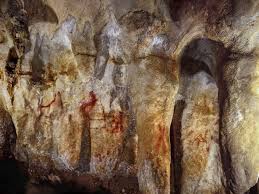
La Pasiega Cave of
Monte Castillo
Puente Viesgo, Cantabria, Spain
65,000 BC
One of the earliest examples of cave art
Used ocher (mineral) as a means of painting
Painting in the Marcos-Pangkep Caves
Sulawesi, Indonesia,
37,000–34,000 BC
Chapter 12 begins here
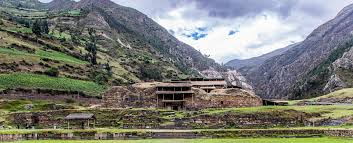
Chavin de Huantar temple compex
900-200BC
Main structure formed by two interconnected temples built at different times
Constricted of post-and-lintel ashlar masonry rather than rammed earth
Decorated woth low-relief sculptures
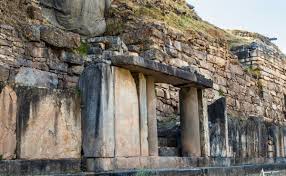
Entry facade to newer section of the Chavin de Huantar temple
400-200 BC
Granite and limestone
Built to awe visitors
Interior passageways only 3 feet wide twisted through the temple
A duct system created a roaring noise
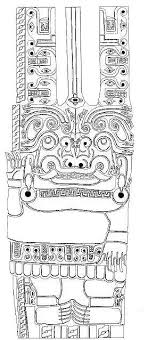
Lanzon Sculpture
Peru
900-200BC
Stone; low-relief
In the center of the old temple: location indicates it was important to the temple complex
Wears human costume elements: ear-flares, collar, and skirt
Iconography merges snakes, caimans, and jaguars with humans
Fierce predators associated with gods and leaders in later societies
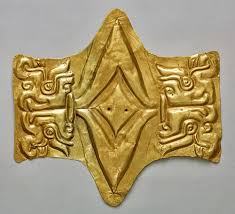
Chavin pectoral
Gold; Repousse
900-500 BC
Chavin de Huantar
Four bird heads (represent the sky) two on each side
Rotated 90 degrees it depicts 2 jawless beings
Would have been visible during ritualistic performances
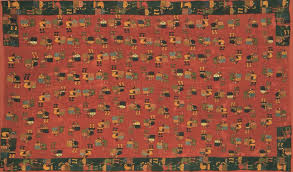
Funerary Mantle with embroidered decoration
Paracas, Peru
First Century CE
Embroidered woven cloth
Figures are meant to be viewed horizontally, like they’re flying through space, stomach down
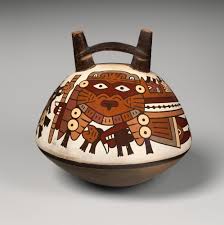
Flying figure vessel
Nasca, Peru
50-200CE
Ceramic with Slip; stirrup jug
Figure gripping human trophy head with one hand
Sense of movement
May indicate an ecstatic religious state made possible by the taking of a trophy head and its associated rituals
The ability to enter trace states was often a route to social prestige and political power
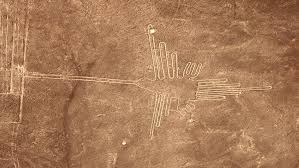
Hummingbird, Nasca lines
Nasca line on a desert plane
Nasca, Peru
500 AC
Removed rocks to reveal the lighter ground underneath, piling rocks on either side of the line
emphasize bold, stylize, and dynamic forms
May have served a religious purpose, possibly sacred paths or marking astronomical phenomena
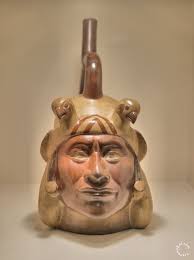
Portrait Vessel
Moche, Peru
400-600 CE
Ceramic with slip
Many Moche ceramic heads represent facial types, suggesting they are portrait types
Attention given to each individual and specific status symbols suggests many of these may represent rulers who were believed to be semi-divine
Usually exhibit no more than 2 colors, typically red on cream
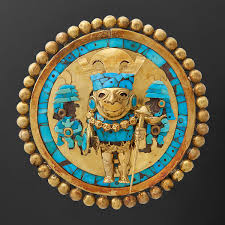
Ear ornament
Moche, Peru
Golf and turquoise
300CE
Wears costume items, including sacrifical knife in the top-middle of the headress, gold nose ring, and ceremonial mace and shield
Buried skeletal remains dressed in similar fashions have been found in Sipan
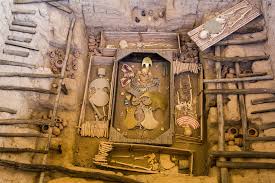
Tomb of a Moche lord
Buried with a gold cresent headdress, mace, and belt decor
Flanked by servants or followers
Items int he burials differed according to the political or religious office held by the deceased
Sipan
Vessel in the form of a seated ruler with a pampas cat
Moche, Peru
Same red-on-cream painting style
Scholars believe the vases depict rituals performed by the richly dressed officeholders seen throughout Moche art
Pampas cats are indigenous to the Moche area